Alan Bean, Fourth Person To Walk On The Moon, Dies At 86
Alan Bean, the fourth man to walk on the Moon, has died at the age of 86
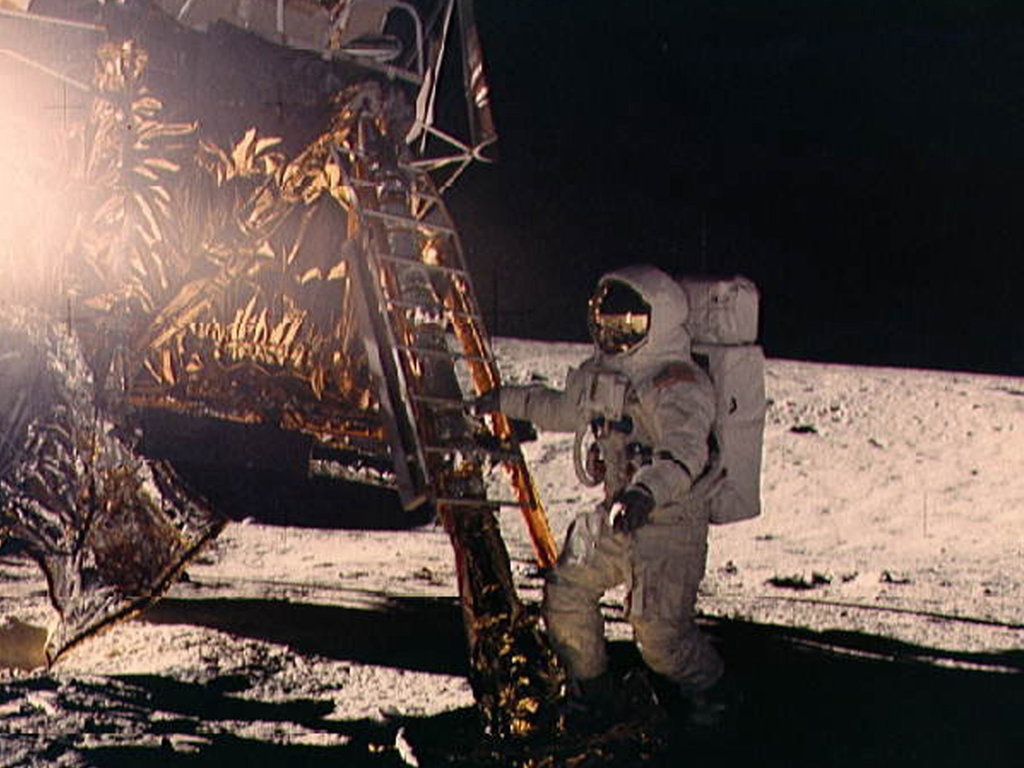
Alan Bean, the fourth person to walk on the Moon, has died at 86:
Alan Bean, who became the fourth man to walk on the moon and turned to painting years later to tell the story of NASA’s Apollo missions as they began receding into history, died on Saturday at Houston Methodist Hospital. He was 86.
His death was announced by his family in a statement released by NASA.
Mr. Bean stepped onto the lunar surface preceded by Pete Conrad, the mission commander of their Apollo 12 flight, in November 1969, four months after Neil Armstrong and Buzz Aldrin became the first lunar explorers.
The flight of Apollo 12, while thrilling in its own right, was not nearly as dramatic as the pioneering mission of Apollo 11, but it resulted in a more extensive exploration of the moon.
Mr. Bean returned to space in July 1973, when he commanded a three-man flight to the orbiting space research station Skylab, the forerunner of the International Space Station. The astronauts on that mission spent 59 days in space, a record at the time.
Twelve astronauts ultimately walked on the moon in six Apollo missions. When Mr. Bean, a former Navy test pilot, left NASA in 1981, he drew on a longstanding interest in painting to become a full-time artist, creating images of the era when science fiction morphed into reality.
Many of Mr. Bean’s fellow astronauts were evidently taken aback by his choosing the art world over private business. “I’d say 60 percent of them thought maybe I was having a midlife crisis,” Mr. Bean recalled in his book “Apollo” (1998), written with Andrew Chaikin, in which he reproduced many of his paintings.
“Every artist has the earth or their imaginations to inspire their paintings,” Mr. Bean told The New York Times in 1994. “I’ve got the earth and my imagination, and I’m the first to have the moon, too.”
Mr. Bean’s paintings drew on his recollections, interviews with fellow astronauts, photos and videos. They included a re-creation of Mr. Armstrong securing an American flag in the lunar dust; Mr. Bean standing alongside Mr. Conrad on the moon, looking toward earth; Eugene A. Cernan riding in a lunar rover during the Apollo 17 mission and the earth rising above the moon.
The Washington Post has more:
Former Apollo 12 astronaut and painter Alan Bean, who was the fourth person to walk on the moon and later turned his passion for space into art, has died. He was 86.
Bean was the lunar module pilot for the second moon landing mission in November 1969. He spent 31 hours on the moon deploying surface experiments with commander Charles Conrad and collecting 75 pounds (34 kilograms) of rocks and lunar soil for study back on Earth, according to a statement from NASA.
Bean died Saturday in Houston, Texas, following a short illness, the statement said.
Bean is the eighth of 12 Apollo moonwalkers to die and the second this year, after the passing of Apollo 16 commander John Young in January.
“As all great explorers are, Alan was a boundary pusher,” NASA Administrator Jim Bridenstine said in a statement that credited Bean with being part of 11 world records in the areas of space and aeronautics. “We will remember him fondly as the great explorer who reached out to embrace the universe.”
In 1998 NASA oral history, Bean recalled his excitement at preparing to fly to the moon.
After Apollo, Bean commanded the second crewed flight to the United States’ first space station, Skylab, in 1973. On that mission, he orbited the Earth for 59 days and traveled 24.4 million miles, setting a world record at the time.
“When you’re getting ready to go to the moon, every day’s like Christmas and your birthday rolled into one. I mean, can you think of anything better?” Bean said.
Born March 15, 1932, in Wheeler, Texas, Bean received a Bachelor of Science degree in aeronautical engineering from the University of Texas in 1955. He attended the Navy Test Pilot School and was one of 14 trainees selected by NASA for its third group of astronauts in October 1963.
“I’d always wanted to be a pilot, ever since I could remember,” Bean said in 1998 NASA oral history. “I think a lot of it just had to do with it looked exciting. It looked like brave people did that. I wanted to be brave, even though I wasn’t brave at the time. I thought maybe I could learn to be, so that appealed to me.”
Bean retired from NASA in 1981 and devoted much of his time to creating an artistic record of space exploration.
His Apollo-themed paintings feature canvases textured with lunar boot prints and embedded with small pieces of his moon dust-stained mission patches.
“Alan Bean was the most extraordinary person I ever met,” astronaut Mike Massimino, who flew on two space shuttle missions to service the Hubble Space Telescope, said in a statement. “He was a one-of-a-kind combination of technical achievement as an astronaut and artistic achievement as a painter.”
Here’s the NASA statement:
HOUSTON, Texas — Apollo and Skylab astronaut Alan Bean, the fourth human to walk on the moon and an accomplished artist, has died.
Bean, 86, died on Saturday, May 26, at Houston Methodist Hospital in Houston, Texas. His death followed his suddenly falling ill while on travel in Fort Wayne, Indiana two weeks before.
“Alan was the strongest and kindest man I ever knew. He was the love of my life and I miss him dearly,” said Leslie Bean, Alan Bean’s wife of 40 years. “A native Texan, Alan died peacefully in Houston surrounded by those who loved him.”
A test pilot in the U.S. Navy, Bean was one of 14 trainees selected by NASA for its third group of astronauts in October 1963. He flew twice into space, first as the lunar module pilot on Apollo 12, the second moon landing mission, in November 1969, and then as commander of the second crewed flight to the United States’ first space station, Skylab, in July 1973.
“Alan and I have been best friends for 55 years — ever since the day we became astronauts,” said Walt Cunningham, who flew on Apollo 7. “When I became head of the Skylab Branch of the Astronaut Office, we worked together and Alan eventually commanded the second Skylab mission.”
“We have never lived more than a couple of miles apart, even after we left NASA. And for years, Alan and I never missed a month where we did not have a cheeseburger together at Miller’s Café in Houston. We are accustomed to losing friends in our business but this is a tough one,” said Cunningham.
On Nov. 19, 1969, Bean, together with Apollo 12 commander Charles “Pete” Conrad, landed on the Ocean of Storms and became the fourth human to walk on the moon. During two moonwalks Bean helped deploy several surface experiments and installed the first nuclear-powered generator station on the moon to provide the power source. He and Conrad inspected a robotic Surveyor spacecraft and collected 75 pounds (34 kilograms) of rocks and lunar soil for study back on Earth.
“Alan and Pete were extremely engaged in the planning for their exploration of the Surveyor III landing site in the Ocean of Storms and, particularly, in the enhanced field training activity that came with the success of Apollo 11. This commitment paid off with Alan’s and Pete’s collection of a fantastic suite of lunar samples, a scientific gift that keeps on giving today and in the future,” said Harrison Schmitt, Apollo 17 lunar module pilot and the only geologist to walk on the moon. “Their description of bright green concentrations of olivine (peridot) as ‘ginger ale bottle glass,’ however, gave geologists in Mission Control all a big laugh, as we knew exactly what they had discovered.”
“When Alan’s third career as the artist of Apollo moved forward, he would call me to ask about some detail about lunar soil, color or equipment he wanted to have represented exactly in a painting. Other times, he wanted to discuss items in the description he was writing to go with a painting. His enthusiasm about space and art never waned. Alan Bean is one of the great renaissance men of his generation — engineer, fighter pilot, astronaut and artist,” said Schmitt.
Four years after Apollo 12, Bean commanded the second crew to live and work on board the Skylab orbital workshop. During the then-record-setting 59-day, 24.4 million-mile flight, Bean and his two crewmates generated 18 miles of computer tape during surveys of Earth’s resources and 76,000 photographs of the Sun to help scientists better understand its effects on the solar system.
In total, Bean logged 69 days, 15 hours and 45 minutes in space, including 31 hours and 31 minutes on the moon’s surface.
Bean retired from the Navy in 1975 and NASA in 1981. In the four decades since, he devoted his time to creating an artistic record of humanity’s first exploration of another world. His Apollo-themed paintings featured canvases textured with lunar boot prints and were made using acrylics embedded with small pieces of his moon dust-stained mission patches.
“Alan Bean was the most extraordinary person I ever met,” said astronaut Mike Massimino, who flew on two space shuttle missions to service the Hubble Space Telescope. “He was a one of a kind combination of technical achievement as an astronaut and artistic achievement as a painter.”
“But what was truly extraordinary was his deep caring for others and his willingness to inspire and teach by sharing his personal journey so openly. Anyone who had the opportunity to know Alan was a better person for it, and we were better astronauts by following his example. I am so grateful he was my mentor and friend, and I will miss him terribly. He was a great man and this is a great loss,” Massimino said.
Born March 15, 1932, in Wheeler, Texas, Bean received a Bachelor of Science degree in aeronautical engineering from the University of Texas in 1955. He attended the Navy Test Pilot School and accumulated more than 5,500 hours of flying time in 27 different types of aircraft.
He is survived by his wife Leslie, a sister Paula Stott, and two children from a prior marriage, a daughter Amy Sue and son Clay.
Unlike Neil Armstrong and Buzz Aldrin, the first two men to walk on the Moon, who were part of the Apollo mission immediately before Bean’s, or many of the Mercury that preceded him and others that followed him, Bean didn’t become a household name. Nonetheless, is one of only twelve people in human history who have walked on the surface of a body other than Earth, for now. With Bean’s passing, only four of those men are still alive — Buzz Aldrin, David Scott, Charles Duke, and Harrison Schmitt, who was the last man to walk on the Moon as part of Apollo 17. Schmitt’s mission ended on December 14, 1972.
Photo of Alan Bean on the Moon via NASA

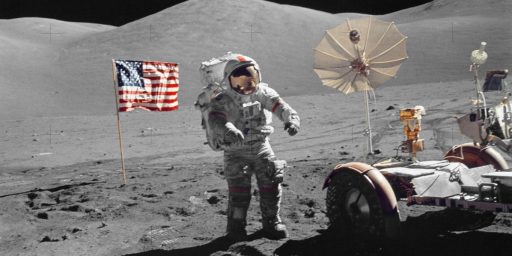
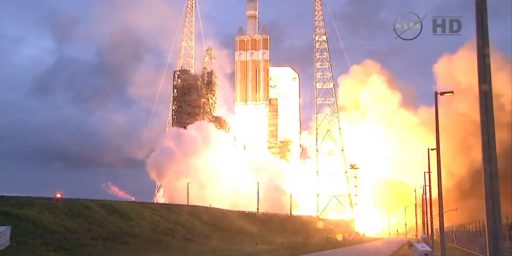
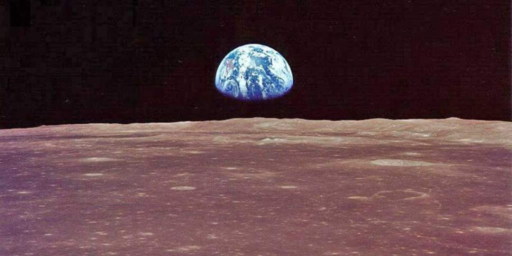
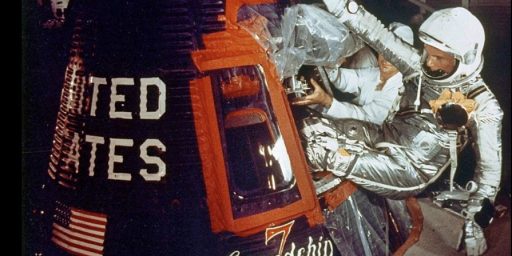
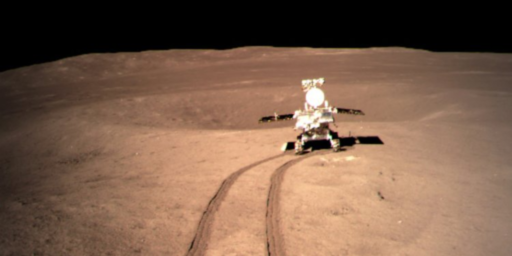
Godspeed, Alan Bean.
Considering that guy knows a buncha astronauts, that’s incredible praise.
Only four men remain who have walked on the Moon. Sadly, it is unlikely anyone will again before those four are gone. RIP Alan Bean, now forever among the stars.
They faked the moon landing 50 years ago — why are they cleaning up the loose ends now?